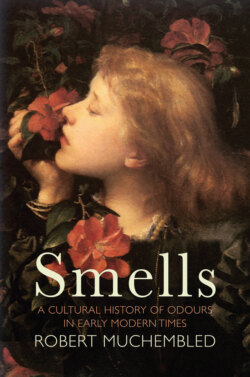Читать книгу Smells - Robert Muchembled - Страница 12
The foul air of medieval towns
ОглавлениеIt is fruitless trying to pinpoint when humans first started getting rid of their rubbish.4 Men have always tried to identify and limit such health hazards. The Middle Ages had a wide range of expressive terms for the principal causes of foul smells: shit, dung, mire, ordure, filth, muck, turds. When the air became too grim to breathe, the populace turned to the authorities to sort it out. In 1363, professors and students at the University of Paris complained to the king that the local butchers
kill their animals in their homes, and the blood and waste from the animals is thrown day and night into the Rue Sainte-Geneviève, and on several occasions the waste and blood of the animals was kept in pits and latrines in their houses until it was corrupted and rotten and then thrown into that same street day and night, until the street, Place Maubert and all the surrounding air was corrupted, foul, and reeking.
Three years later (the wheels of justice turned slowly, then as now), the Paris parliament ordered the butchers to slaughter their animals outside the city on the river before bringing them back into the capital for sale, or face fines if they refused.5
Odour pollution was often caused by animals, as towns and villages were full of horses needed for travel and transport, as well as poultry, pigs and goats, left to forage the streets for food, even in Paris. Then there were the strays, mainly dogs, which proliferated though men were employed to catch and kill them: these men were paid by the head, particularly in urban areas under Burgundian control. Only when epidemics seriously threatened did the authorities make temporary attempts to limit the number of animals, whose excrement was a regular feature of urban life. The same was true of humans, who ‘made water’, defecated or spat wherever the need took them.
Certain trades were a major source of noxious emissions for their immediate neighbourhood, including butchers, tripe makers, fishmongers, potters (who deliberately left their clay to sour in cellars in Paris and elsewhere), and painters who used pigments made from metal oxides. The worst were tanners, glove- and purse-makers, and fullers, who made abundant use of toxic plant and animal substances as mordants, like alum, tartar and soda, urine (often collected from humans), chicken droppings and dog excrement, which accelerated the process of fermenting and rotting the fibres they worked with. Attempts were made to force the smelliest and most harmful trades away from the overcrowded centres of towns and villages to the outskirts and downstream on rivers to keep the water at least vaguely drinkable. However, the growth of urban centres in the late medieval period only made the toxic pollution worse. More and more complaints were made about ‘fetor’, or foul smells, fetid water and unhealthy air, particularly in the warm summer months, when the atmosphere was simply impossible to breathe. Growing awareness of the problem led to progress in a number of areas, including the establishment of ‘privies’ and latrine pits shared by men and women, often placed at the back of a yard or giving onto a river. Efforts were also made to instil greater discipline in those living in such urban centres and to force the local authorities to take action to limit the accumulation of rubbish, combat dangerous emissions from latrines and graveyards, and prevent the pollution of streets, canals and rivers. While financial penalties played their part, the most significant steps were the installation of public latrines, sewers and gutters, and paving the main streets. However, real improvements were several centuries in the making.
